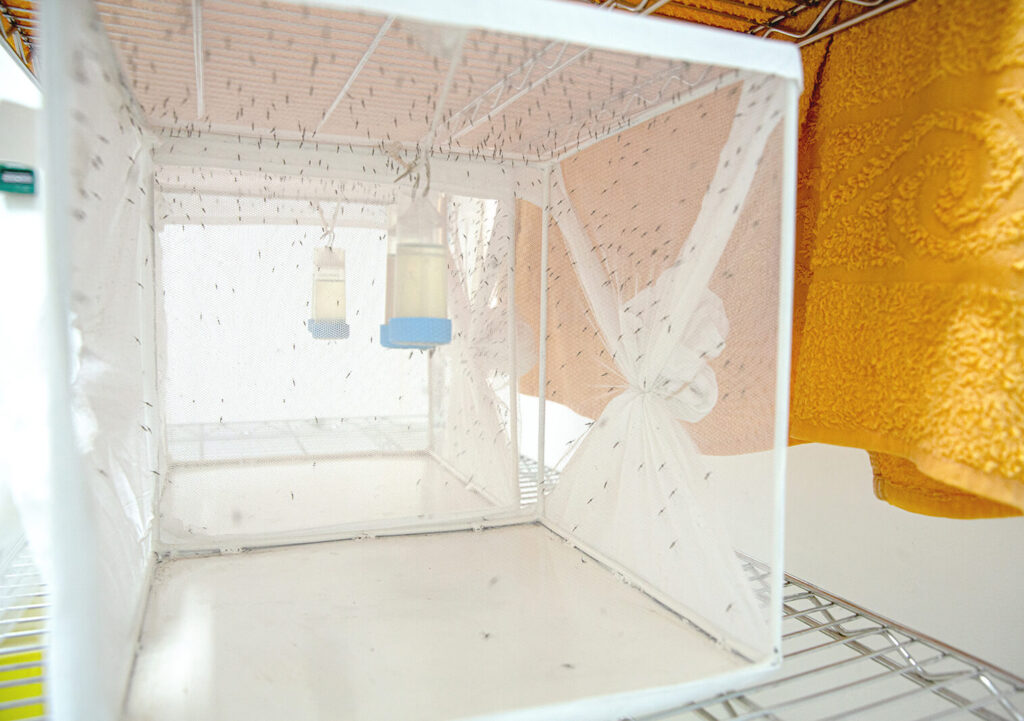A War On Mosquitoes:
Scientist Turn to Gene-drive Technology to Stop Malaria
Written by: Hope Kalamira. Video Explainer By Hellen Kabahukya
Written by: Hope Kalamira. Video Explainer By Hellen Kabahukya
Inside a caged room, an insectary at the Uganda Virus Research Institute (UVRI), lives different types of mosquitoes.
These flies are being monitored constantly for investigation by scientists. The goal is to ascertain whether populations of these malaria-carrying insects can be reduced by genetic modification.
The study is being led by scientists at the Entebbe-based facility in collaboration with research consortium Target Malaria.
Their plan to use gene drive technology to wipe out species of mosquitoes carrying the parasitic illness represents the most promising path to eradicating the disease.
‘The hope is to help develop a vector control tool for the suppression of malaria transmission,” says Dr. Jonathan Kayondo the head of Entomology at UVRI
If all goes to plan, this could very well be the last century in Ugandan history when people die from malaria, he adds .
The Ancient old Pandemic
The World Health Organization published its annual World Malaria Report, finding that after the Covid-19 pandemic, there had been an increase in malaria incidence and mortality rates.
In this report, five countries bore the brunt of the global malaria case increases between 2021 and 2022.
These countries had 5 million additional cases observed, three being in Africa in Ethiopia, Nigeria having 1.3 million cases each and Uganda had over 597,000 cases.
Indicating that Uganda has one of the highest global burden of malaria cases, with over 90% of the population at risk, thus remaining Uganda’s leading cause of death, especially in children.
As of 2022, the cases of malaria stood at 12.7 million and over 17,556 estimated deaths in the country. This costs the country an average economic loss over $500 million annually.

Dr. Jonathan Kayondo, the Entomology at Uganda Virus Research Institute. Photo by Richard Mugambe.
Malaria and the climate
Climate change is the biggest threat to people’s health and wellness, especially for those who are already struggling.
A changing climate can directly affect malaria transmission due to the sensitivity of the malaria parasite and the mosquito to temperature, rainfall and humidity.
“The ideal temperature for mosquito breeding and survival occurs at ranging from 20–27° C, with mortality increasing above 28° C,” Dr Kayondo explains
Uganda experiences weather conditions that often allow transmission to occur all year round due to its tropical nature with only a few areas that experience low or unstable transmission.
Malaria is spread by Plasmodium parasites that are affected by temperature where their development slows as the temperature drops and stops at high temperatures, which is the reason why parasites can be found in temperate areas.
“When you look at highland areas like Kigezi highlands which span districts like Kisoro, Kabale, you find that there are low cases of malaria but also due to climate change you find that those regions now have cases of malaria.” Dr Kayondo explains.
Climate affects both the parasite and the mosquito. Mosquitoes are unable to survive in low humidity and their breeding grounds are expanded by rainfall.
“A malaria parasite needs a temperature that is optimal for it to grow before it can be spread from one human to another” Dr. Explains.
This means that the higher the temperature the faster the mosquito parasite grows and in low or cool temperatures parasite development is slow or is very unlikely to happen.
This explains why in areas like Kigezi where temperatures are known to be cool, malaria cases are seasonal or non-existent and in the Acoli and Lango sub regions where temperatures are known to be high, there are very high rates of malaria cases.
“If the temperature changes in places previously known to be malaria free zones this could lead to new malaria cases allowing us to see malaria in those parts where we have not seen it in. ” He further adds.
Over 90% of Uganda is high transmission area and we are in the tropics and if it’s gradual, it may look more like the case where the high altitude areas will also become very endemic and so the picture is likely to get worse.”

Mosquitoes caged for research purposes at Uganda Virus Research Institute. Photo by Richard Mugambe.
The complexity and cost of carrying out repeat interventions such as spraying and mosquito net distributions, combined with issues of growing resistance to insecticide and anti-malarial drugs, are threatening to reverse progress on malaria elimination.
That’s where Target Malaria comes in. In partnership with the national research center UVRI, they have been conducting meticulous research.
For years they have been investigating the viability of using a gene drive, a kind of self-propagating genetic alteration that altered organisms pass along to all their offspring, to wipe out three specific species of mosquito that are responsible for the majority of the disease’s transmission.
“The mosquitoes we are looking into represent a tiny fraction of the 3,500 mosquito species on Earth, and so the gene drive prevents the three species that spread malaria from producing new females that infect humans,” Dr. Kayongo explains adding, “This could dramatically reduce malaria transmission, faster and cheaper than any other method.”
The objective of the genetic modifications is to reduce the number of female Anopheles gambiae mosquitoes because they are the ones who transmit malaria when they bite humans.
“If we could alter the ability to reproduce, an attempt to try and suppress mosquito population because if you can limit the numbers that are being produced and if you can consistently do this over a time, a time comes when you have fewer numbers which should result in reduced transmission,” Dr. Kayondo emphasizes.
These enzymes recognise and cut very specific sequences of DNA. In Target Malaria’s case, there researchers precisely cut and therefore disrupt the specific gene sequences of interest ,such as fertility genes or sex determination genes that will impact reproduction and thus population size.
This reduces the malaria mosquito population relatively cost-effective and sustainable to implement because the mosquitoes themselves do the work.
© 2022 - Media Challenge Initiative | All Rights Reserved .
© 2022 - Media Challenge Initiative | All Rights Reserved .